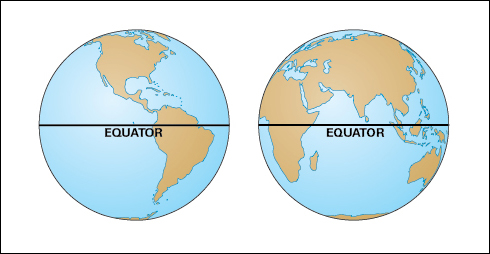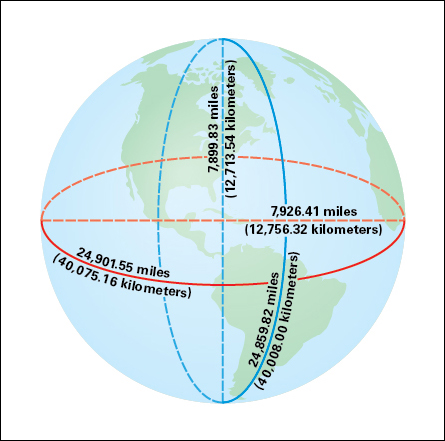Equator is the great circle of Earth that lies halfway between the North and South poles. This imaginary line divides the earth into two equal parts called the Northern Hemisphere and the Southern Hemisphere. It is the starting point for the degrees of latitude that measure distances north and south from the equator to the poles (see Latitude). The latitude of the equator is zero. On a globe, the equator is also a line on which equal distances are marked to show degrees of longitude, which measures east and west distances (see Longitude). The circumference of the earth at the equator is 24,901.55 miles (40,075.16 kilometers). Each degree of longitude at the equator equals 69.17 miles (111.32 kilometers).

The location of the equator can be determined by observing the elevation of the North Star or the sun above the horizon. Allowing for slight corrections, the angle of elevation of the North Star at any given place equals the latitude of that place. Thus, at the equator, the North Star is barely visible above the horizon and has an elevation of nearly zero degrees.
The equatorial climate.
The climate along the equator varies according to altitude and the distance from the sea. In most equatorial lowlands, heavy rains and average temperatures are uniform all year. But the east coast of Africa has only light rain and a long dry season. Quito, Ecuador, which lies almost exactly on the equator, has an elevation of 9,350 feet (2,850 meters). It has a uniform temperature that is about 25 Fahrenheit degrees (14 Celsius degrees) cooler than nearby lowlands.

The celestial equator
is an imaginary circle that goes around the sphere in which the earth and heavenly bodies lie. It helps locate stars and planets. See Astronomy (Locating objects in space).
The magnetic equator
is an irregular imaginary line near the geographic equator. At any point on the magnetic equator, a magnetized needle balances horizontally. See Magnetic equator.
